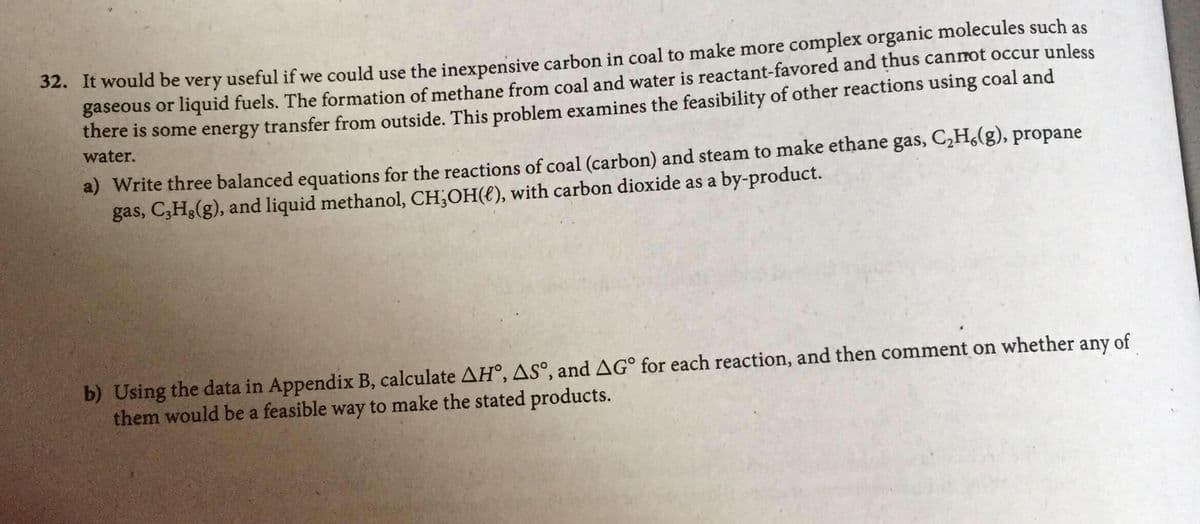52. It would be very useful if we could use the inexpensive carbon in coal to make more complex organic molecules such as gaseous or liquid fuels. The formation of methane from coal and water is reactant-favored and thus cannot occur unless there is some energy transfer from outside. This problem examines the feasibility of other reactions using coal and water. a) Write three balanced equations for the reactions of coal (carbon) and steam to make ethane gas, C¸H,(g), propane gas, C,Hs(g), and liquid methanol, CH;OH(), with carbon dioxide as a by-product.
52. It would be very useful if we could use the inexpensive carbon in coal to make more complex organic molecules such as gaseous or liquid fuels. The formation of methane from coal and water is reactant-favored and thus cannot occur unless there is some energy transfer from outside. This problem examines the feasibility of other reactions using coal and water. a) Write three balanced equations for the reactions of coal (carbon) and steam to make ethane gas, C¸H,(g), propane gas, C,Hs(g), and liquid methanol, CH;OH(), with carbon dioxide as a by-product.
Chemistry: The Molecular Science
5th Edition
ISBN:9781285199047
Author:John W. Moore, Conrad L. Stanitski
Publisher:John W. Moore, Conrad L. Stanitski
Chapter16: Thermodynamics: Directionality Of Chemical Reactions
Section: Chapter Questions
Problem 120QRT
Related questions
Question
100%
Refer to the attached photo. Thank you!

Transcribed Image Text:2. It would be very useful if we could use the inexpensive carbon in coal to make more complex organic molecules such as
gaseous or liquid fuels. The formation of methane from coal and water is reactant-favored and thus cannot occur unless
there is some energy transfer from outside. This problem examines the feasibility of other reactions using coal and
water.
a) Write three balanced equations for the reactions of coal (carbon) and steam to make ethane gas, C,H,(g), propane
gas, C,H3(g), and liquid methanol, CH;OH(€), with carbon dioxide as a by-product.
b) Using the data in Appendix B, calculate AH°, AS°, and AG° for each reaction, and then comment on whether any of
them would be a feasible way to make the stated products.
Expert Solution
This question has been solved!
Explore an expertly crafted, step-by-step solution for a thorough understanding of key concepts.
Step by step
Solved in 2 steps

Knowledge Booster
Learn more about
Need a deep-dive on the concept behind this application? Look no further. Learn more about this topic, chemistry and related others by exploring similar questions and additional content below.Recommended textbooks for you

Chemistry: The Molecular Science
Chemistry
ISBN:
9781285199047
Author:
John W. Moore, Conrad L. Stanitski
Publisher:
Cengage Learning

General Chemistry - Standalone book (MindTap Cour…
Chemistry
ISBN:
9781305580343
Author:
Steven D. Gammon, Ebbing, Darrell Ebbing, Steven D., Darrell; Gammon, Darrell Ebbing; Steven D. Gammon, Darrell D.; Gammon, Ebbing; Steven D. Gammon; Darrell
Publisher:
Cengage Learning

Chemistry & Chemical Reactivity
Chemistry
ISBN:
9781337399074
Author:
John C. Kotz, Paul M. Treichel, John Townsend, David Treichel
Publisher:
Cengage Learning

Chemistry: The Molecular Science
Chemistry
ISBN:
9781285199047
Author:
John W. Moore, Conrad L. Stanitski
Publisher:
Cengage Learning

General Chemistry - Standalone book (MindTap Cour…
Chemistry
ISBN:
9781305580343
Author:
Steven D. Gammon, Ebbing, Darrell Ebbing, Steven D., Darrell; Gammon, Darrell Ebbing; Steven D. Gammon, Darrell D.; Gammon, Ebbing; Steven D. Gammon; Darrell
Publisher:
Cengage Learning

Chemistry & Chemical Reactivity
Chemistry
ISBN:
9781337399074
Author:
John C. Kotz, Paul M. Treichel, John Townsend, David Treichel
Publisher:
Cengage Learning

Chemistry for Engineering Students
Chemistry
ISBN:
9781337398909
Author:
Lawrence S. Brown, Tom Holme
Publisher:
Cengage Learning

Chemistry: Principles and Reactions
Chemistry
ISBN:
9781305079373
Author:
William L. Masterton, Cecile N. Hurley
Publisher:
Cengage Learning

Chemistry: An Atoms First Approach
Chemistry
ISBN:
9781305079243
Author:
Steven S. Zumdahl, Susan A. Zumdahl
Publisher:
Cengage Learning